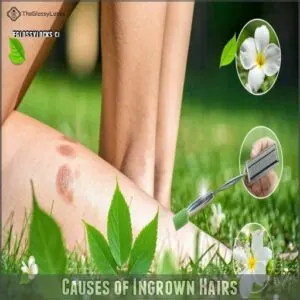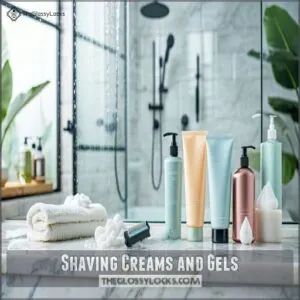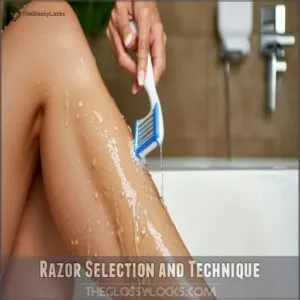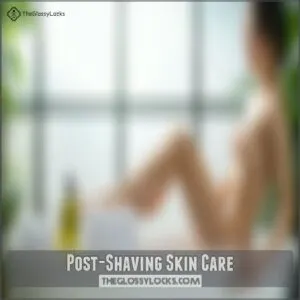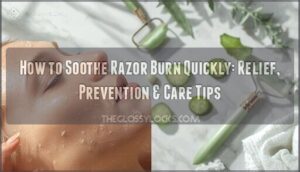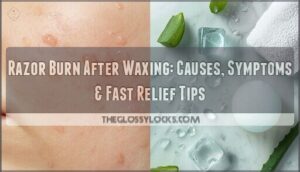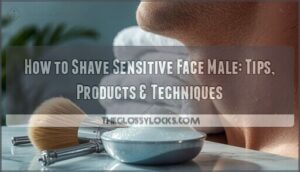This site is supported by our readers. We may earn a commission, at no cost to you, if you purchase through links.
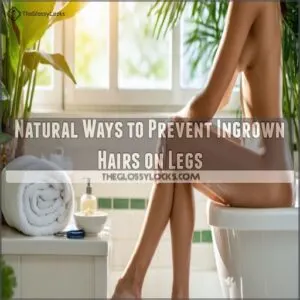
Exfoliation is key; think of it as spring cleaning for your pores. A gentle scrub with a yogurt-oatmeal mix can do wonders.
Also, ditch the dull razor – it’s practically begging for ingrown hairs. Shaving with the grain and moisturizing afterwards are your new best friends.
Ready to conquer those pesky bumps? There’s more to uncover about achieving flawlessly smooth legs.
Table Of Contents
- Key Takeaways
- Causes of Ingrown Hairs
- Preventing Ingrown Hairs
- Natural Remedies for Ingrown Hairs
- Post-Shaving Skin Care
- Maintaining Healthy Skin
- Frequently Asked Questions (FAQs)
- What can I put on my legs to prevent ingrown hairs?
- How do I stop picking ingrown hairs on my legs?
- What naturally draws out an ingrown hair?
- How do you get rid of ingrown hairs on your legs permanently?
- Does diet impact ingrown hair development?
- Can certain fabrics worsen ingrown hairs?
- Are there specific vitamins for ingrown hair prevention?
- How does stress affect ingrown hair occurrence?
- Is dry brushing helpful for preventing ingrown hairs?
- Conclusion
Key Takeaways
- Exfoliate your legs regularly with gentle scrubs like sugar or oatmeal to remove dead skin and prevent hairs from getting trapped.
- Always use a sharp, clean razor and shave with the grain to avoid irritation and reduce the risk of ingrown hairs.
- Moisturize your skin with natural options like coconut oil or body butter after shaving to keep it hydrated and smooth.
- Wear loose, breathable fabrics like cotton to minimize friction and irritation that can lead to ingrown hairs.
Causes of Ingrown Hairs
You’re about to learn why those pesky ingrown hairs pop up on your legs. Several factors, from shaving techniques to your hair type, can cause those annoying bumps.
Shaving and Tweezing Risks
Shaving mistakes and tweezing dangers often lead to ingrown hairs on legs.
A dull razor or pulling your skin taut while shaving can cause razor burns and ingrown bumps.
Tweezing, while precise, can break the hair beneath the skin, increasing the risk of skin irritation and those pesky ingrown hairs.
To minimize these risks, consider learning about shaving techniques that promote smooth skin.
Avoid these practices to prevent ingrown hairs and keep your legs smooth.
Dead Skin Cells and Curly Hair
Beyond shaving mishaps, dead skin cells and curly hair also contribute to ingrown hairs legs.
Think of your hair follicles like tiny tunnels, dead skin can clog these tunnels, trapping curly hair underneath.
This leads to inflammation and those pesky bumps, exfoliate legs naturally and embrace a solid curly hair care routine to prevent ingrown hairs by improving skin texture and hair follicle health.
Regular dead skin removal is key for preventing ingrown hairs caused by trapped hairs.
Poor Shaving Techniques
Along with curly hair and dead skin, poor shaving techniques can also lead to ingrown hairs legs.
Blunt razors and shaving against the grain are common shaving mistakes, creating razor burns and skin irritation.
This traps hair follicles, causing ingrown bumps.
Proper shaving techniques, like using a sharp razor and shaving with the grain, help prevent ingrown hairs and razor burn remedies are helpful for soothing skin.
Master these leg shaving tips for smoother, bump-free skin.
Preventing Ingrown Hairs
You can prevent ingrown hairs on your legs with a few simple changes to your routine.
These changes include proper shaving techniques, which are crucial for preventing ingrown hairs.
Exfoliation, and moisturizing to keep your skin healthy and smooth are also important aspects of this routine.
Exfoliating Dead Skin Cells
Now that you know what causes ingrown hairs, let’s conquer them.
One of your best weapons? Exfoliation! Regularly removing dead skin cells with gentle exfoliants like sugar scrubs, natural loofahs, or skin brushes helps prevent ingrown hairs.
This clears the way for hairs to grow straight, giving you smooth legs naturally and preventing those pesky bumps. Using a natural leg exfoliator can be particularly effective in this process.
Try exfoliating your legs naturally twice a week for best results.
Shaving Creams and Gels
Shaving irritation and razor burn can be a real drag, but the right shaving cream or gel can be your skin’s best friend.
Never shave dry–lubrication is key to prevent ingrown hairs. Creams offer extra moisture, while gels excel at razor glide. Both help your razor move smoothly and keep your skin hydrated, minimizing irritation and ingrown hairs.
For more information on shaving tips can help you achieve a smoother shave.
- Soothe with a moisturizing shaving cream.
- Glide with a lubricating shaving gel.
- Banish razor burn and prevent ingrown hairs.
Razor Selection and Technique
Beyond shaving cream, your razor and technique play a huge role in preventing ingrown hairs and razor burn.
A sharp, clean razor is key. Shave with the grain, using light pressure.
Rinse your razor after each stroke. Proper razor maintenance, blade sharpness, and shaving angles, along with minimal skin tension, will keep your legs smooth and bump-free.
Understanding Razor Blade Care is essential for achieving the best results.
Clean your razor with rubbing alcohol after each use.
Natural Remedies for Ingrown Hairs
Dealing with pesky ingrown hairs on your legs? You can find relief with a few simple, natural remedies that’ll help soothe irritation and prevent future ingrown hairs.
Hot Compress Treatments
For ingrown hair prevention, warm water therapy works wonders.
Try warm compress wraps or heat applications to soothe irritated skin.
Warm compresses boost blood flow, softening the skin and aiding pore cleansing.
This simple, natural remedy for ingrown hairs can prevent ingrown hairs and soothe irritated skin, offering a natural, effective solution.
Regular use of this warm water therapy can be a game-changer.
Yogurt and Oatmeal Mix
Another surprising dynamic duo for preventing ingrown hairs is Yogurt and oatmeal.
Yogurt’s properties, including lactic acid and vitamins, offer skin soothing and natural exfoliation.
Oatmeal benefits include inflammation reduction and a calming effect on irritated skin.
This simple mix helps soothe irritated skin, gently removes dead skin cells, and is a great natural post shave care and natural hair removal companion.
This combo is one of the best natural remedies for ingrown hairs.
Aspirin and Honey Treatment
Beyond yogurt and oatmeal, an aspirin-honey paste offers sweet relief.
Crush uncoated aspirin, mix with honey, and apply for 10 minutes. Aspirin’s salicylic acid and honey’s natural properties gently exfoliate, soothe skin, and control infection.
This dynamic duo tackles ingrown hairs, preventing razor bumps naturally. This home remedy is part of a natural post-shave care routine that helps prevent ingrown hairs on your legs.
Post-Shaving Skin Care
Proper post-shave care keeps your legs smooth and prevents ingrown hairs. You’ll learn how to moisturize and protect your skin to minimize irritation and enjoy touchably soft legs.
Moisturizing and Hydrating
Keeping your skin hydrated is key for happy legs.
After shaving, lock in moisture with a natural moisturizer. Some great options include:
1.Hydrating creams,
2.Natural oils like coconut oil, and 3. Body butters.
This boosts skin health, softens skin, and helps prevent ingrown hairs on your legs.
Choose natural skin care for your legs and find the moisturizer type that works best for you.
Aftershave Creams and Gels
Along with moisturizing, aftershave is key for post shave care legs.
Apply an alcohol-free aftershave cream or gel to soothe razor burns and prevent ingrown hair.
Look for skin soothers like aloe in the gel ingredients.
Using aftershave cream products can provide additional benefits.
This extra aftershave benefits step helps keep ingrown hair prevention a breeze, offering natural remedies ingrown hair and preventing razor bumps.
Your legs will thank you.
Reducing Friction and Irritation
Beyond aftershave, consider how clothes rub against your skin.
Friction can spark irritation and ingrown hairs.
Here’s your guide to freedom from friction:
- Choose loose-fitting clothes.
- Ditch the skinny jeans post-shave.
- Opt for gentle fabrics like cotton.
- Loose boxers or briefs are your skin’s best friend.
Understanding soothe irritated skin is important for preventing razor bumps and soothing leg irritation.
This friction management is key for preventing razor bumps and soothing leg irritation.
Maintaining Healthy Skin
You can prevent ingrown hairs by keeping your skin healthy through simple routines. This includes regular exfoliation and choosing clothing that doesn’t restrict hair follicles.
Regular Exfoliation
After pampering your legs with aftershave, regular exfoliation becomes your next skincare secret weapon.
This removes dead skin, paving the way for healthy hair growth and preventing ingrown hairs.
Try sugar scrubs and skin brushes for gentle massage during your daily routine.
Understanding the exfoliation frequency is important for maintaining healthy skin.
| Exfoliating Tool | Benefit |
|---|---|
| Sugar Scrubs | Gentle exfoliation |
| Skin Brushes | Stimulates circulation |
| Exfoliating Tools | Variety of options |
| Gentle Massage | Improves effectiveness |
| Daily Routine | Consistent care |
Avoiding Tight Clothing
Tight clothing, especially around your legs, can cause friction and skin irritation, increasing your risk of ingrown hairs.
Opt for loose-fit clothing and breathable fabrics like cotton to minimize skin friction.
Choosing comfort wear over tight clothing helps prevent ingrown hairs and keeps your skin happy.
Smart fabric choices reduce friction, preventing skin irritation and those pesky ingrown hairs, by making breathable fabrics and comfort wear essential choices.
Frequently Asked Questions (FAQs)
What can I put on my legs to prevent ingrown hairs?
To prevent ingrown hairs, keep your skin moisturized with gentle, natural lotions. Regularly exfoliate with a sugar scrub to prevent dead skin from trapping hairs.
How do I stop picking ingrown hairs on my legs?
Distract your hands. Cover the area. If the urge is overwhelming, get a sterile needle and tweezers. Ask a friend for help if you can’t stop.
What naturally draws out an ingrown hair?
A warm compress can help. It softens the skin and may allow the trapped hair to surface. You could also try a sugar scrub to gently exfoliate the area.
How do you get rid of ingrown hairs on your legs permanently?
Sadly, there’s no magic potion for permanent banishment. Laser or electrolysis offer the best shot, but even those aren’t foolproof.
Does diet impact ingrown hair development?
While no direct link exists between diet and ingrown hairs, nourishing your body with healthy foods promotes overall skin health, which may indirectly reduce your risk.
Can certain fabrics worsen ingrown hairs?
Tight clothes, like Pharaoh’s mummy wraps, can trap hairs. Loose-fitting, breathable fabrics like cotton help prevent ingrown hairs by reducing friction and letting your skin breathe.
Are there specific vitamins for ingrown hair prevention?
Vitamins A and C, along with vitamin E, can support healthy skin and potentially reduce ingrown hairs.
A balanced diet rich in these nutrients may help, but it’s not a guaranteed fix.
How does stress affect ingrown hair occurrence?
Funny how stress sneaks into everything, including your skin.
When you’re stressed, your body releases hormones like cortisol, which can worsen inflammation and slow healing, increasing your chances of pesky ingrown hairs popping up.
Chill out, seriously, and reduce stress.
Is dry brushing helpful for preventing ingrown hairs?
Dry brushing helps keep ingrown hairs at bay by exfoliating dead skin cells and unclogging pores.
Use a soft-bristled brush on dry legs in gentle, circular motions before showering to encourage smoother hair growth.
Conclusion
Smooth, bump-free legs don’t have to be a distant dream.
Think of proper care as your secret weapon against ingrown hairs. By exfoliating regularly, using natural remedies, and moisturizing after shaving, you’ll keep those pesky bumps at bay.
Swap dull razors for fresh ones and stick to shaving techniques that work with your hair’s natural growth.
These natural ways to prevent ingrown hairs on your legs are simple, effective, and easy to stick with for healthy, happy skin.
- https://www.healthline.com/health/ingrown-hair-on-legs
- https://www.medicalnewstoday.com/articles/322858
- https://www.nhs.uk/conditions/ingrown-hairs/
- https://www.gillettevenus.com/en-us/womens-shaving-guide/sensitive-skin/how-to-treat-ingrown-hairs/
- https://www.sandandsky.com/blogs/news/ingrown-leg-hairs

